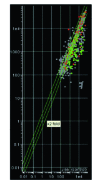Comment on "Effect of biofilm formation by clinical isolates of Helicobacter pylori on the efflux-mediated resistance to commonly used antibiotics"
- PMID: 28970736
- PMCID: PMC5597512
- DOI: 10.3748/wjg.v23.i33.6194
Comment on "Effect of biofilm formation by clinical isolates of Helicobacter pylori on the efflux-mediated resistance to commonly used antibiotics"
Abstract
Attaran et al[1] have recently shown that decreased susceptibility of established Helicobacter pylori (H. pylori) biofilms to specific antibiotics, was associated with the overtly enhanced transcription of two efflux pump genes, hp1165 and hefA, involved in specific resistance to tetracycline and multiple antibiotics, respectively. Apart from antibiotic exposure, secretion of multiple antimicrobial peptides, such as human β-defensins (hβDs), by the gastric epithelium upon Hp challenge, may act as early triggering events that positively impact biofilm formation and thus, antibiotic resistance. In this regard, we undertook genomic transcriptional studies using Hp 26695 strain following exposure to sublethal, similar to those present in the gastric niche, concentrations of hβDs in an attempt to provide preliminary data regarding possible mechanisms of immune evasion and selective sensitivity of Hp. Our preliminary results indicate that hβD exposure ignites a rapid response that is largely due to the activation of several, possibly interconnected transcriptional regulatory networks - origons - that ultimately coordinate cellular processes needed to maintain homeostasis and successful adaptation of the bacterium in the gastric environment. In addition, we have shown that both antibiotic and hβD resistance are mediated by dedicated periplasmic transporters, including the aforementioned efflux pump genes hp1165 and hefA, involved in active export of antibiotics from the cell membrane and/or, as recently suggested, substrate sensing and signalling. Furthermore, it appears that sublethal doses of hβDs may enhance biofilm formation by the sustained expression of, mainly, quorum sensing-related genes. In conclusion, we provide additional data regarding the role of specific innate immune molecules in antibiotic cross-resistance mechanisms that may deepen our understanding in the context of the development of novel eradication regimens.
Keywords: Antimicrobial resistance; Biofilm; Helicobacter pylori; Human β-defensins.
Conflict of interest statement
Conflict-of-interest statement: The authors declare no conflict of interest.
Figures

Comment on
-
Effect of biofilm formation by clinical isolates of Helicobacter pylori on the efflux-mediated resistance to commonly used antibiotics.World J Gastroenterol. 2017 Feb 21;23(7):1163-1170. doi: 10.3748/wjg.v23.i7.1163. World J Gastroenterol. 2017. PMID: 28275296 Free PMC article.
References
-
- Kountouras J, Deretzi G, Gavalas E, Zavos C, Polyzos SA, Kazakos E, Giartza-Taxidou E, Vardaka E, Kountouras C, Katsinelos P, et al. A proposed role of human defensins in Helicobacter pylori-related neurodegenerative disorders. Med Hypotheses. 2014;82:368–373. - PubMed
-
- Bessa LJ, Grande R, Di Iorio D, Di Giulio M, Di Campli E, Cellini L. Helicobacter pylori free-living and biofilm modes of growth: behavior in response to different culture media. APMIS. 2013;121:549–560. - PubMed
Publication types
MeSH terms
Substances
LinkOut - more resources
Full Text Sources
Other Literature Sources
Medical
Research Materials
Miscellaneous

